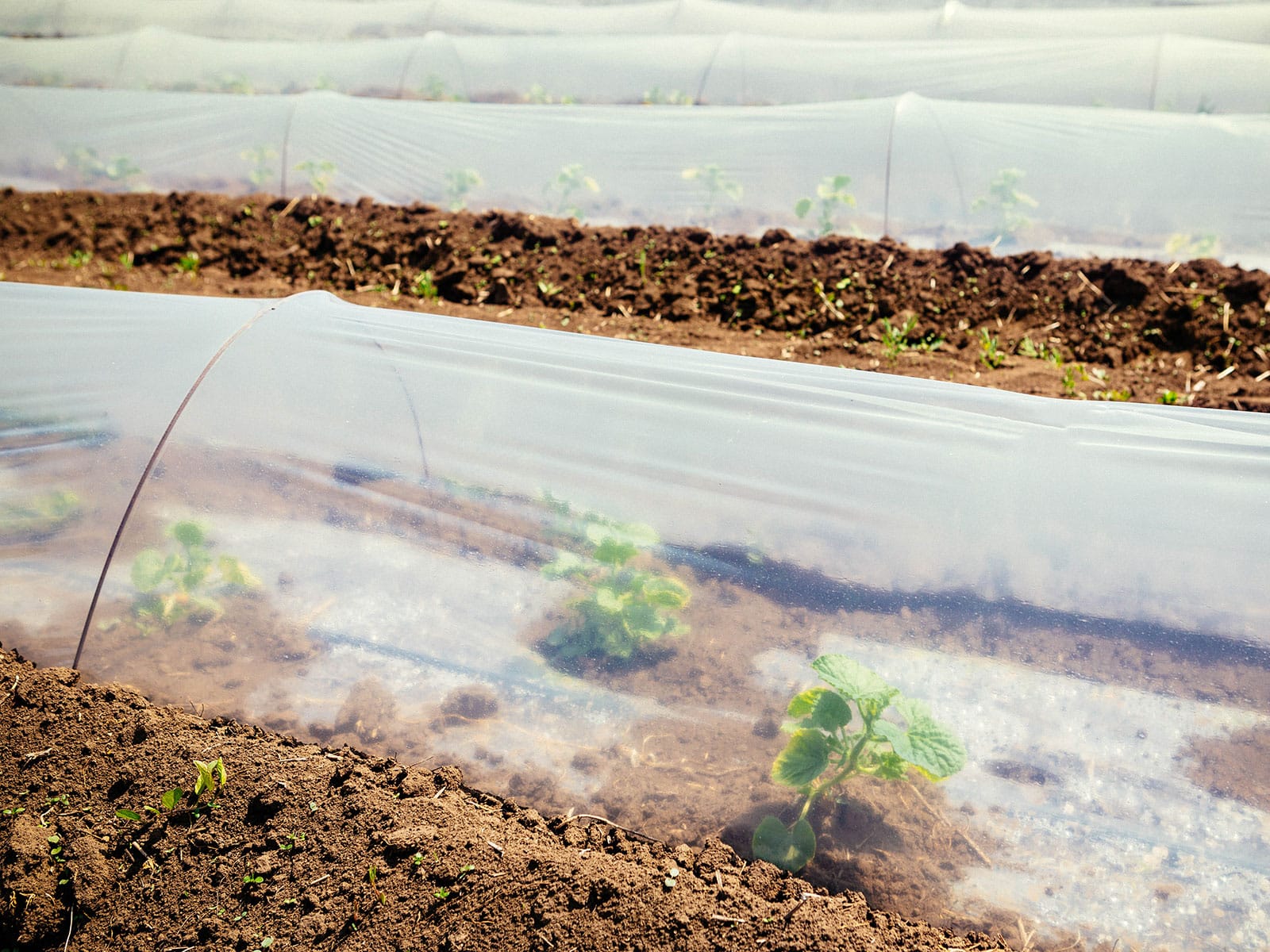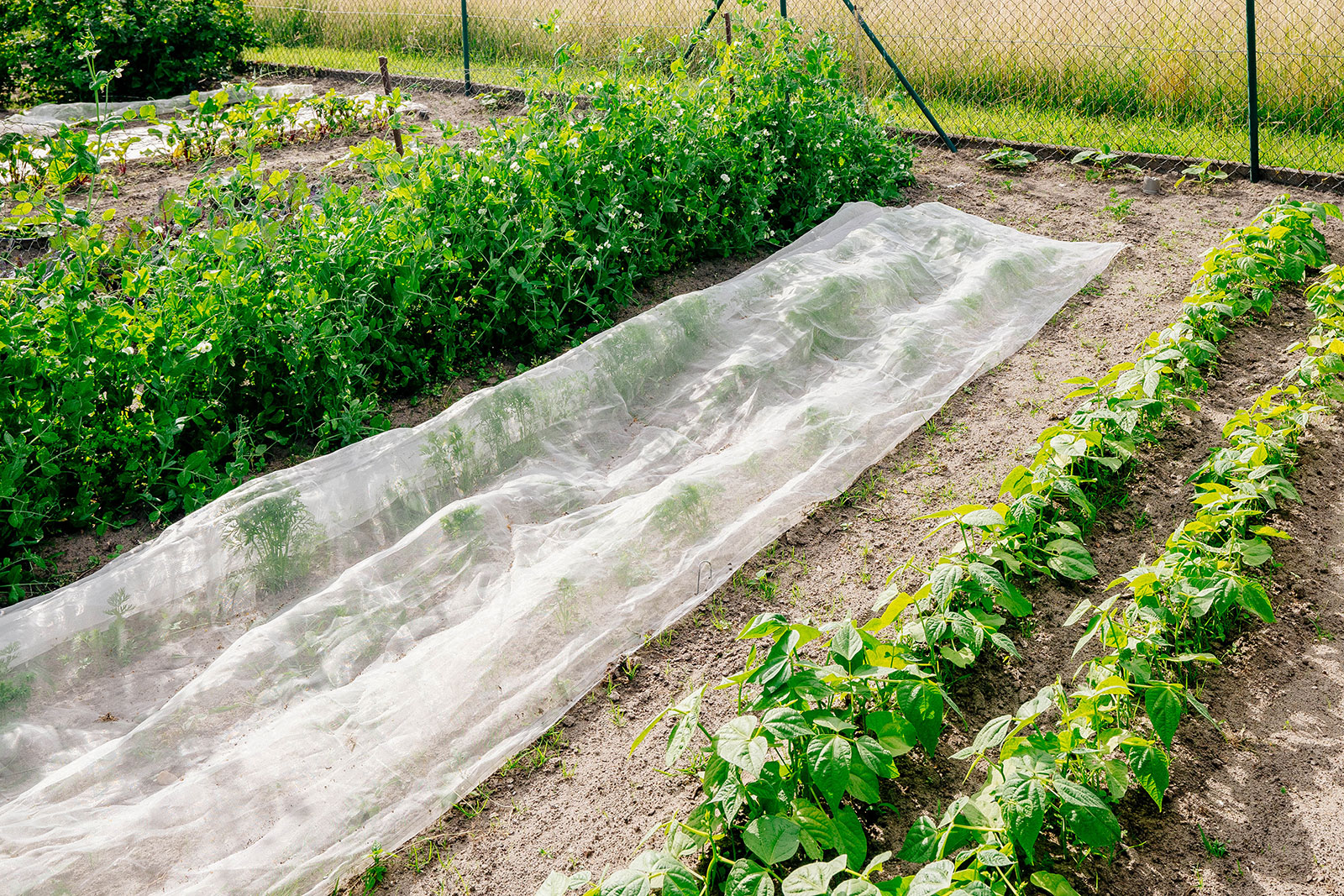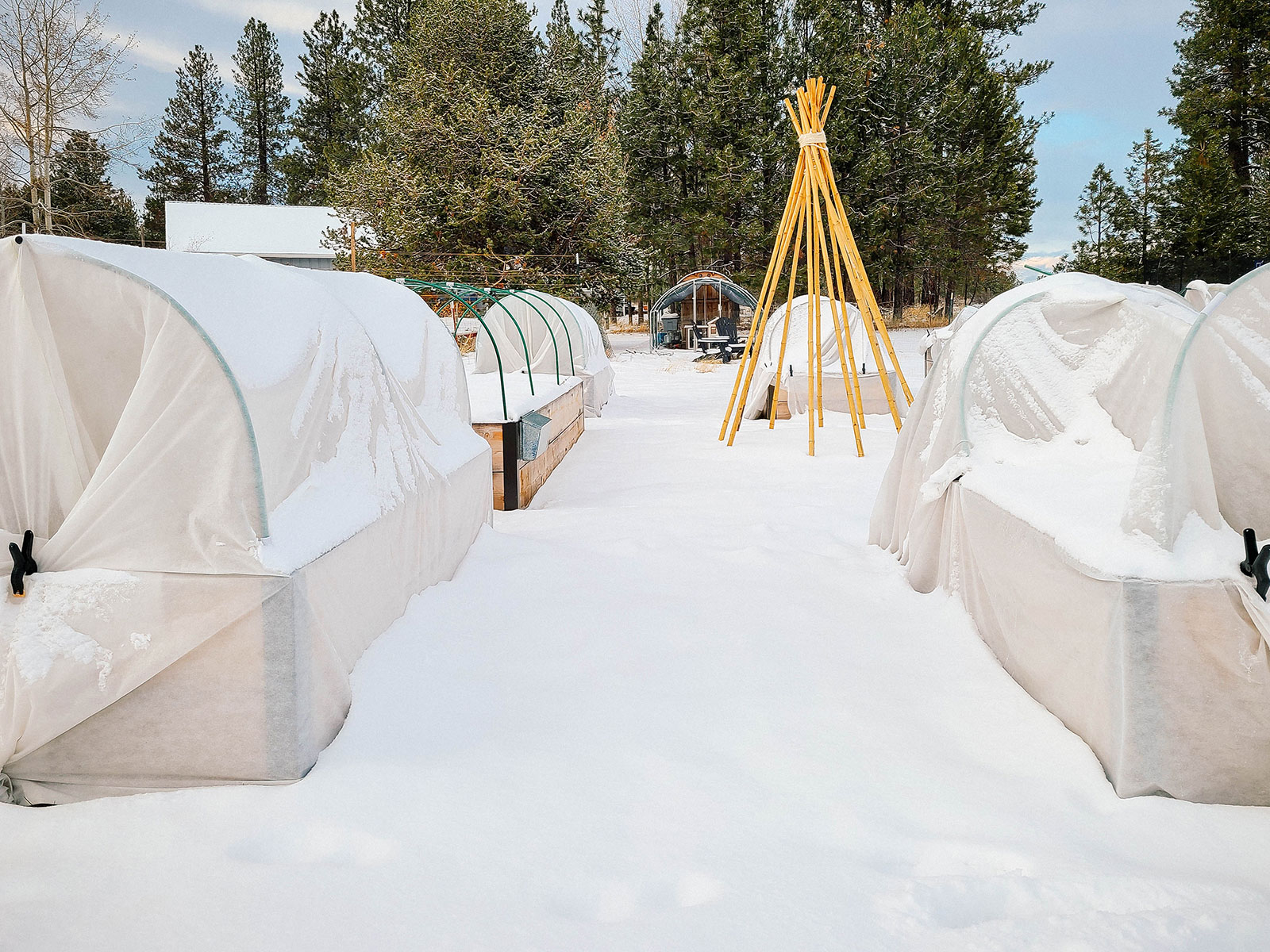If you’ve considered season extension methods to help you grow in early spring, in the peak of summer, or into winter, you know that row covers are key to a successful harvest. Sometimes it’s hard to imagine how a scant few millimeters of fabric or plastic sheeting can protect your plants, but selecting the right row cover can make all the difference in your plants surviving cold, heat, hail, or bugs.
Row cover is typically made from two types of materials: polyethylene plastic or spunbonded fabrics (like polyester or polypropylene). They come in various thicknesses and weights to suit a range of needs and climates, and the ones below are what I’ve used in my own garden.
Disclosure: If you shop from my article or make a purchase through one of my links, I may receive commissions on some of the products I recommend.
Polyethylene plastic covers

Polyethylene plastic covers (also called greenhouse plastic or greenhouse film) are generally used for greenhouses, high tunnels, and low tunnels. Many are UV-treated for more durability, but if you’re on a budget, you can use plain construction-grade plastic sheeting found at any hardware or home improvement store.

Clear plastic generates and holds more heat than fabric, so it can protect more tender plants in winter. However, it can heat up so quickly that it becomes challenging to manage, especially if your climate has wide temperature shifts. Even a sunny 40°F day can be detrimental to plants inside a plastic-covered tunnel if you don’t vent it! For that reason, some plastic covers are perforated to allow for better temperature control.
Plastic sheeting
Spunbonded fabrics

Spunbonded fabrics are used on low tunnels to protect against frost (which is why they’re sometimes called frost cloth, frost blankets, or frost covers, or simply, garden fleece). They’re not a fabric like a cloth fabric you might think of, but a very light web of poly fibers stuck together. Because they’re permeable to water and air, they let in rain and allow for natural ventilation.
Frost cloth is available by weight, measured in ounce per square yard. This not only indicates their degree of frost protection, but also how much sunlight they let in. I usually prefer a medium-weight frost cloth for growing plants in winter without a greenhouse. It’s a good compromise between insulation (typically providing around 5°F of cold protection) and light transmission (around 70 percent, which helps when daylight is already so limited in winter).
| Weight | Light | Protection | |
|---|---|---|---|
| Light | 0.55 oz. | 85% | 2° to 4° |
| Medium | 0.9 oz. | 70% | 4° to 6° |
| Heavy | 1.5 oz. | 50% | 6° to 8° |
| Extra heavy | 2.0 oz. | 30% | 8+° |
Could you use a bed sheet or other fabric as a frost cover? In a pinch, yes. But an actual frost cover is designed to protect plants without risk of damage, since it dries quickly and provides proper airflow.
If you grow cold-hardy vegetables that are appropriate for your climate, a medium-weight cover is often all the insulation they’ll need from late fall to early spring. You can always double up on the fabric for those polar vortex days. For overwintering containers, you can step up to a heavyweight or extra heavyweight frost cloth.

I personally use Agribon, which is an industry standard that comes in rolls. If you go with another brand, be sure to check its weight so you know how much frost protection you’re actually getting.
Frost cloth
Floating row covers

Floating row covers are very lightweight covers that specifically protect against pests early in the season. The material “floats” directly over the plants and is held down by landscape pins, rocks, or bricks, so you don’t need to erect a frame or tunnel. The plants underneath support the floating row cover and push it up as they grow.
It’s important to use a floating row cover over your bed before you think you’ll need it—think late winter to mid spring when you’re sowing seeds or transplanting seedlings. Otherwise, you risk trapping an insect underneath the cover and having it reproduce without a way of getting out.
Lightweight spunbonded fabrics are often marketed as floating row covers. You can even use sheer white tulle or organza from the fabric store as an insect barrier.
Floating row covers
Insect netting

Insect netting has no heat retention properties. It looks and feels like a soft, flexible window screen, and comes with different mesh opening sizes to deal with different insects. In general, smaller mesh openings are better as they’ll exclude more insects, but a denser mesh also means it’ll transmit less light and build up heat more easily.
So, what’s the difference between insect netting vs. floating row covers? In terms of use, mostly durability. Insect netting can last several years with proper storage, while floating row covers and lightweight fabrics are usually pretty delicate and may need to be replaced every couple of seasons.
Insect netting
Bird netting

Bird netting has wider mesh openings that are large enough for some insects to pass through, but small enough to keep birds (and other small pests like rabbits) from nibbling on tender transplants. Bird netting is also a good insurance policy for a newly seeded bed!
I’ve found that quality varies widely, as some types of bird netting are so fragile that they start tearing right out of the package, while others are durable enough to last a few seasons.
Bird netting
Shade cloth

Shade cloth is another type of row cover that’s used in summer to block a certain amount of sunlight. It’s typically a dark, coarsely woven poly (with mesh openings that fall somewhere between insect netting and bird netting) that you drape over a low tunnel, tomato cage, or other structure to provide shade for plants.
This is helpful for growing lettuce in summer or protecting tomatoes from blossom drop. Depending on what you’re growing and how large your plants are, shade cloth doesn’t need to cover an entire bed down the sides. You can attach it to your low tunnel like a canopy to shade your plants during the hottest part of the day.
Though this will depend on your climate, a 30 percent to 40 percent shade cloth should reduce enough heat without blocking too much light.
Shade cloth
Hail netting

Hail netting is typically made from a high-density polyethylene mesh that can withstand hail damage. The fibers are woven in such a way that they still retain their shape when struck by hail.
If you live in an area where summer hailstorms are common, this is a useful row cover to add to your collection so you don’t lose any of your crops. That said, a regular fabric cover can also work if you mostly only get small amounts of pea-sized hail.
Hail netting
How to use row covers
Most row covers are used over a low tunnel. You can build a simple and inexpensive low tunnel with PVC pipe, EMT conduit, or galvanized steel wire (like this 9-gauge wire, which can be cut to any size you need). Bend the pipe or wire into an arc (a “hoop”) to fit your bed, stick the ends of the hoops into the ground, then spread the cover over the hoops and secure them with clips or clamps.
Row cover clamps
Low tunnels are generally 2 to 4 feet wide, and at least 18 inches high. (My own low tunnels are 4 feet high to accommodate larger plants, since I often get late spring to early summer frosts in my garden.)
You can also purchase low tunnel kits that come with pre-formed or connectable hoops. Some of them (like Easy Tunnels, linked below) even have fleece or poly covers permanently attached to the hoops. The entire tunnel folds out like an accordion, making it quick and easy to cover your plants on the fly.
















What would you recommend for protecting seedlings and providing shade in Phoenix? Temperatures are already sneaking into the 90s. I made friends with the quail and they love my seedlings! Thanks!
Shade cloth for sure! I’d go with 40% shade and see how that works in your garden. I’m in the high desert and use 40% shade cloth to protect tomatoes and other plants in summer (where it often gets above 95F).
My biggest problem using row covers is the wind. It tends to shred any materials I have used very quickly. What you recommend to use for very windy garden spaces?
I use Agribon year-round in my garden (in summer, it’s just clipped to the top of my low tunnels) and it typically lasts 3 years before it starts to shred. We have a very harsh climate here that includes wind, snow, and high desert sun. If your row covers aren’t lasting that long, you should try a different brand that may be more durable. For holding them down, I use the white tube clamps along the top ridge of my tunnel and on the top half of the fabric, and clip the bottom half with clamps (so I can get into the tunnels more easily). They’ve survived strong gusts this way without shredding or blowing away.